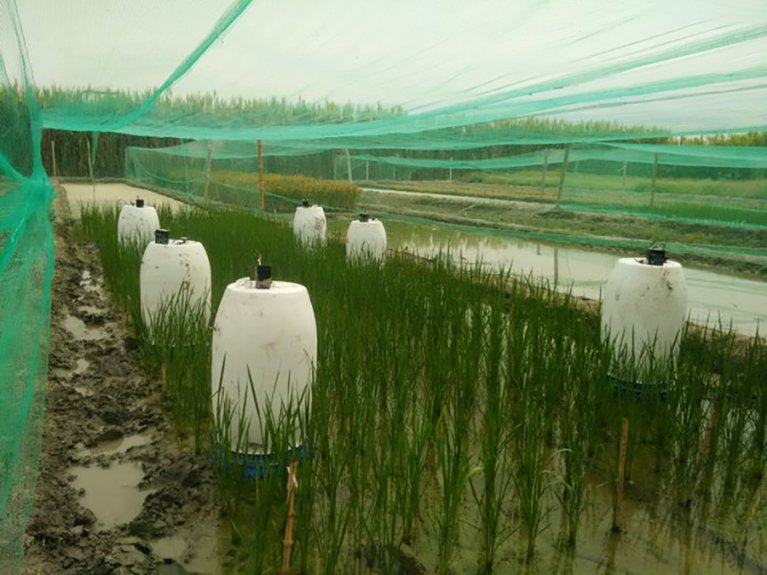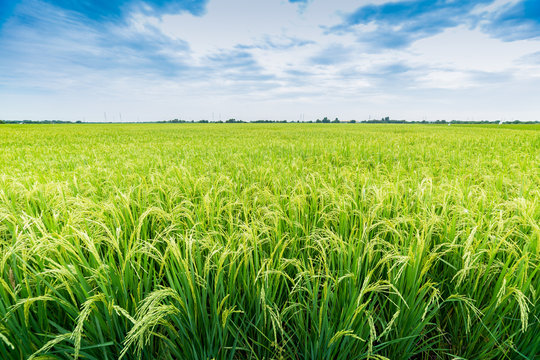Methane, a potent greenhouse gas, imparts a greenhouse effect 25 times stronger than that of carbon dioxide per unit agricultural input. Given that methane contributes around 30% of greenhouse gas emissions in the agricultural sector, precise measurement of methane emissions from rice paddy soil holds significant importance in formulating effective climate change response policies.
The Methane Evaluation Technology
The widely employed approach for measuring methane emissions from rice paddy soil is the chamber method, which entails the placement of box-shaped chambers at appropriate distances on the soil. The collected methane is then quantified per unit area and time. However, this method has limitations, as it lacks continuous monitoring capability and provides results confined to specific chamber areas, potentially distorting emission levels.

Methane is measured via number of techniques to assess climate mitigation strategies; the one shown in the image is through AWD (Alternate Wetting and Drying).
Image Source: Climate & Clean Air Coalition
It was a collaborative effort from Dr. Namgoo Kang from KRISS (Korea Research Institute of Standards and Science) and Dr. Minseok Kang from NCAM (The National Center for Agro Meteorology) on the pioneering study, resulting in the development of an innovative technology that improves the accuracy of measuring methane emissions from rice paddy fields. Their findings have been documented in Agricultural and Forest Meteorology and published in the journal Elsevier.
The modern eddy covariance method provides a solution to the limitations associated with the chamber method, allowing for continuous measurement of methane emissions from rice paddy soil across open and expansive areas. Eddy covariance method is utilized to directly observe the gaseous interchange, analyze energy and momentum exchange within and between the ecosystems and atmosphere.
However, a challenge arises from the potential influence of measurement equipment height on the accuracy of the results, which depends on the specific soil conditions. Unfortunately, there is currently insufficient research and guidelines available to address this concern. As a result, the chamber method continues to be utilized for calculating country-specific emission factors required for inclusion in the United Nations Framework Convention on Climate Change (UNFCCC) database.
The team from KRISS and NCAM provided a rectified methodology based on a study in Cheorwon, Gangwon-do Province, during 2020 and 2021.
The key factor behind this accomplishment is the utilization of KRISS-developed methane reference gas technology, enabling precise calibration for both the chamber method and the eddy covariance method. The research thereby represents the first application of internationally recognized standards in measuring methane emissions from rice paddy soil.
These findings have practical implications, as they can be employed to verify national greenhouse gas emission data and enhance the reliability of information through a comparative analysis of the chamber method and the eddy covariance method. Furthermore, this research has the potential to enhance measurement accuracy and facilitate data integration within global greenhouse gas observation networks.
Dr. Namgoo Kang, emphasized the outcomes of this study will contribute to the establishment and implementation of plans aimed at achieving carbon neutrality across agriculture, forestry, and livestock industries at the national level by 2050.
Moving forward, the collaborative research team intends to continue their investigations, with a particular focus on exploring the applicability of the eddy covariance method in forestry, horticulture, and livestock industries. They are committed to advancing their efforts by creating tailor-made quality management technology specifically designed for smart agriculture, which will facilitate precise tracking of greenhouse gas levels.













